Inspect the Rails in a
Motorcar
(from "Cross Ties", 4th Quarter 1997)
By Eric Schwandt
Editor's
Note: Eric Schwandt works in the Track Department at Livemois Yard in Detroit
.
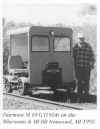 An
interesting way to collect, enjoy and use railroad history is collecting
railroad motorcars. These pieces of equipment that were vital to the railroads
until a few years ago are a user-type hobby. Once a motorcar has been restored
and made mechanically safe, it is time to get it on the rails. I must add -
legally on the rails!
An
interesting way to collect, enjoy and use railroad history is collecting
railroad motorcars. These pieces of equipment that were vital to the railroads
until a few years ago are a user-type hobby. Once a motorcar has been restored
and made mechanically safe, it is time to get it on the rails. I must add -
legally on the rails!
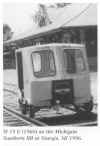 A motorcar is a small car used to inspect track and used by section gangs to
get
to work locations. They replaced the pump cars as used on TV shows such as
Petticoat Junction. Motorcars, in this country, were first mass produced by the
Fairmont Company of
Fairmont,
MN. I would guess that 80% of all motorcars
produced in this country since 1910 are Fairmonts. In Canada, the Sylvester pre-dates the
Fairmont
by three years. A Sylvester motorcar is very
rare and a desirable collector piece. Fairmont
cars were basically unchanged from 1910 until
the middle 60's. The same engine design, a two-cycle, one-cylinder engine was designed by Horace Woolery in 1907.
In the mid 60's, Fairmont
started using a two-cylinder air cooled engine
due to the railroads expanding section gang and track inspector's territory. By
the late 70's, the hi rail truck had pretty much replaced the motorcar. In Canada, motorcars survived until the mid nineties. At
this time most of these cars have been sold off to scrap dealers and collectors.
A motorcar is a small car used to inspect track and used by section gangs to
get
to work locations. They replaced the pump cars as used on TV shows such as
Petticoat Junction. Motorcars, in this country, were first mass produced by the
Fairmont Company of
Fairmont,
MN. I would guess that 80% of all motorcars
produced in this country since 1910 are Fairmonts. In Canada, the Sylvester pre-dates the
Fairmont
by three years. A Sylvester motorcar is very
rare and a desirable collector piece. Fairmont
cars were basically unchanged from 1910 until
the middle 60's. The same engine design, a two-cycle, one-cylinder engine was designed by Horace Woolery in 1907.
In the mid 60's, Fairmont
started using a two-cylinder air cooled engine
due to the railroads expanding section gang and track inspector's territory. By
the late 70's, the hi rail truck had pretty much replaced the motorcar. In Canada, motorcars survived until the mid nineties. At
this time most of these cars have been sold off to scrap dealers and collectors.
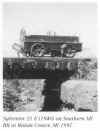 To get started in the hobby is relatively inexpensive. A fix-it-up car price
will start at $500 and up to $5,000 for a deluxe restored enclosed car with
seats, radio and heat. A snowmobile trailer will suffice to haul it. The cars
weigh from 600 to 1,800 pounds. Extension handles make it possible for one
person to lift them on and off tracks.
To get started in the hobby is relatively inexpensive. A fix-it-up car price
will start at $500 and up to $5,000 for a deluxe restored enclosed car with
seats, radio and heat. A snowmobile trailer will suffice to haul it. The cars
weigh from 600 to 1,800 pounds. Extension handles make it possible for one
person to lift them on and off tracks.
There are two national organizations that
promote the hobby: both stress SAFETY AS THE #1 PRIORITY. Safe, legal operation
has opened many railroads in the US
and
Canada
to motorcar excursions. An operator must
demonstrate that he/she can properly run the car, and if the meet is sponsored
by the North American Railcars Operators Association (NARCOA), the operator must
carry a $10 million liability insurance policy. At the present time, there are
about 1,000 NARCOA members. The Motor Car Collectors of America (MCCA) has
several hundred members. Both groups have a newsletter several times a year that
includes ads, how-to tips, history of long lost companies, and motorcar meets.
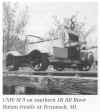 The
price of a meet is usually a few dollars. Meets can be from five miles to
several hundred miles and several days long. One enterprising enthusiast started
a motorcar tour business that features runs to Mexico's Copper
Canyon, runs to the Northern parts of
British Columbia, and trips on the Algoma Central from the Soo,
Ontario
to
Hearst, Ontario, Canada.
The
price of a meet is usually a few dollars. Meets can be from five miles to
several hundred miles and several days long. One enterprising enthusiast started
a motorcar tour business that features runs to Mexico's Copper
Canyon, runs to the Northern parts of
British Columbia, and trips on the Algoma Central from the Soo,
Ontario
to
Hearst, Ontario, Canada.
 During
the summer months, there are meets nearly every weekend in the
Midwest. This past weekend, October 19, I had the
pleasure of running from north of Atlanta,
Georgia, into Tennessee
through the western Great
Smokie
Mountains. The tracks dated to the Civil War times. It is
now the Georgia Northeastern Railroad, and a twenty mile section is owned by the
State of Georgia. This section of track had not seen a train in
twenty-two years. It is being opened up for a tourist train operation next
Spring. Living in the flat land of southern Michigan
makes me appreciate the mountainous states in
the Southeast.
During
the summer months, there are meets nearly every weekend in the
Midwest. This past weekend, October 19, I had the
pleasure of running from north of Atlanta,
Georgia, into Tennessee
through the western Great
Smokie
Mountains. The tracks dated to the Civil War times. It is
now the Georgia Northeastern Railroad, and a twenty mile section is owned by the
State of Georgia. This section of track had not seen a train in
twenty-two years. It is being opened up for a tourist train operation next
Spring. Living in the flat land of southern Michigan
makes me appreciate the mountainous states in
the Southeast.
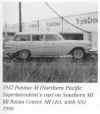 One
of my favorite runs was on the old Clinchfield Railroad from Marion,
North Carolina, to Erwin,
Tennessee. This line intertwines with the Blue Ridge Parkway
up the spine of the Smokies and the Blue Ridge Mountains. There are so many tunnels that you can be in
one, see through the next one and see the entrance to the third. This is now CSX
trackage. My all time greatest experience was running a motorcar from Bennett
Lake, British Columbia, to
Skagway,
Alaska, on the White Pass & Yukon Railroad.
One
of my favorite runs was on the old Clinchfield Railroad from Marion,
North Carolina, to Erwin,
Tennessee. This line intertwines with the Blue Ridge Parkway
up the spine of the Smokies and the Blue Ridge Mountains. There are so many tunnels that you can be in
one, see through the next one and see the entrance to the third. This is now CSX
trackage. My all time greatest experience was running a motorcar from Bennett
Lake, British Columbia, to
Skagway,
Alaska, on the White Pass & Yukon Railroad.
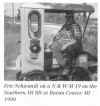 Many
of the older lines that Conrail found unprofitable have been purchased and
operated as shortline roads. A lot of history can be seen by motorcarring on
these lines. A lot of them were the original mainlines when the railroads were
first laid in the mid 1800's. I've been over many miles of tracks in the present
Dearborn Division that at onetime were the mains that formed the Lake Shore,
Pennsylvania, Michigan Central and New York Central systems. By following the
older routes, it is easy to understand how the rail routes of the 1800's opened
up the Midwest
. Basically, if a town wasn't on a railroad
line, it wasn't much of a town for long.
Many
of the older lines that Conrail found unprofitable have been purchased and
operated as shortline roads. A lot of history can be seen by motorcarring on
these lines. A lot of them were the original mainlines when the railroads were
first laid in the mid 1800's. I've been over many miles of tracks in the present
Dearborn Division that at onetime were the mains that formed the Lake Shore,
Pennsylvania, Michigan Central and New York Central systems. By following the
older routes, it is easy to understand how the rail routes of the 1800's opened
up the Midwest
. Basically, if a town wasn't on a railroad
line, it wasn't much of a town for long.
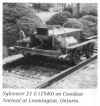 When I hired in on the Penn Central,
there were a few motorcars around the
Detroit
area, but I never worked where one was used. By
the time Conrail took over, they had disappeared. Some of the older fellows who
remember them all seem to have the same memory of them -they were cold and
smelly. I can agree. Two- cycle oil fumes keep the bugs away. I prefer the old
cars with no roofs or windows -open cars. I've been rained and snowed on in
several states and Canada.
When I hired in on the Penn Central,
there were a few motorcars around the
Detroit
area, but I never worked where one was used. By
the time Conrail took over, they had disappeared. Some of the older fellows who
remember them all seem to have the same memory of them -they were cold and
smelly. I can agree. Two- cycle oil fumes keep the bugs away. I prefer the old
cars with no roofs or windows -open cars. I've been rained and snowed on in
several states and Canada.
If
you like old mechanical machines, riding on the railroads, and railroad history,
you sound like a motorcar candidate to me.
Return to the Motor Car Page
Last Edited 28 January, 2018
 An
interesting way to collect, enjoy and use railroad history is collecting
railroad motorcars. These pieces of equipment that were vital to the railroads
until a few years ago are a user-type hobby. Once a motorcar has been restored
and made mechanically safe, it is time to get it on the rails. I must add -
legally on the rails!
An
interesting way to collect, enjoy and use railroad history is collecting
railroad motorcars. These pieces of equipment that were vital to the railroads
until a few years ago are a user-type hobby. Once a motorcar has been restored
and made mechanically safe, it is time to get it on the rails. I must add -
legally on the rails! 





